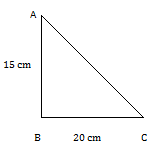CLASS-8
PYTHAGORAS' THEOREM
PYTHAGORAS’ Theorem –
Pythagoras was a Greek mathematician who came up with a relation between the areas of the squares (constructed) on the sides of a right-angled triangle. He figured out that the square on the hypotenuse is equal to the sum of the squares on the other two sides. In the figure, this would mean AC² = AB² + BC², since the area of a square is the square of its side. So, Pythagoras’ theorem, as the relation is called, is a relation between the sides of a right-angled triangle as well.
The converse of the theorem is also true. That means if the square on one side of a triangle is equal to the sum of the squares on the other two sides then those two sides contain a right-angle and the triangle is a right-angled triangle. To put it simply, if an ∆ ABC is such that AC²= AB²+ BC², then ∠B = 90⁰ and ∆ ABC is right angled.
Example) Calculate the length of the unknown side in each of the following triangles

Ans.) As per the Pythagoras theorem AC²= BC²+ AB²
As per the above given picture AB = 15 cm and BC = 20 cm
So, AC² = 20² + 15² = 400 + 225 = 625
Or, AC = √625 = √25² = 25 (Ans.)